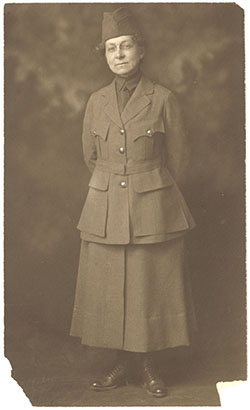When it came time to form the State Normal and Industrial College (now UNCG) in 1891, student health was of the utmost importance. And since the student body was comprised of young women, President Charles Duncan McIver wanted to provide the students with a campus physician who could care for all their needs. Miriam Bitting served one year as campus physician before marrying and moving to New York. The start of the second year of the young college saw a need for a new physician to take Dr. Bitting’s place. Upon the recommendations of several of her instructors and mentors, including a letter from Emily Blackwell, the third woman in the United States to earn a medical degree, Dr. Anna Maria Gove was hired as the second woman physician for State Normal in 1893.
Anna Gove was born on July 6, 1867 in Whitefield, New Hampshire to Maria Pierce and Dr. George Sullivan Gove. As the only daughter of a physician, Anna was exposed to the profession from a young age. It was said that she often rode with her father on the back of his buggy to visit patients around the area. So it seemed natural for Anna to pursue a medical career, even in a time when there were so few women doctors. She attended Massachusetts Institute of Technology and Woman’s Medical College of the New York Infirmary where she graduated in 1892. After a one year internship at the New York Infant Asylum in New York City, Dr. Gove came to Greensboro.
Dr. Gove brought progressive ideas to the little woman’s college in North Carolina. She formulated and put into practice a system for every freshman to have a physical and medical examination upon entering school. She would then lay out plans to correct minor medical defects while the student was at college. State Normal was the third college in the United States to adopt this practice.
Even with Dr. Gove’s diligence, illness came to the school through a number of epidemics. She saw the students through a large measles outbreak in 1895. Keeping the sick women quarantined away from their fellow students and reassuring parents of their daughters’ well-being kept Dr. Gove busy. When the typhoid epidemic descended on campus in 1899, Dr. Gove worked night and day to discover the source of the problem and assist the dozens of sick and dying students. Shortly after the epidemic passed, Dr. Gove took a leave of absence from the school to recoup and recover both mentally and physically.
Perhaps because the typhoid epidemic left such and impression on Dr. Gove, she had a passion for keeping up-to-date on the changing medical field. She took several leaves of absence from the school throughout her early career to increase her medical knowledge. In 1896-1897, she spent a year studying internal medicine in Vienna, Austria. She returned to Vienna in 1913-1914 to continue her post graduate studies, where she met and worked with the famous orthopedist, Adolf Lorens. Dr. Gove even assisted on one of his surgeries.
With the outbreak of WWI, Dr. Gove looked for a way to become involved in the war effort. Women doctors were not accepted into the army medical corps, so Dr. Gove sought another way to put her skills to use. In March 1918, she joined the American Red Cross and travelled to France to serve with the Children’s Bureau in Marseille. Dr. Gove worked with refugee children, assisting with dietary and other health concerns. After the war, she served with the Smith College Relief Unit in Somme, France, before returning to the college in 1920.
Dr. Gove spent much of the 1920s developing a Health and Hygiene Department at the college. She attended numerous lectures at the University of Michigan on mental and physical hygiene and brought that knowledge back to North Carolina. Dr. Gove was a pioneer in the detection and control of tuberculosis at colleges and was asked to read a paper on the subject at the meeting of the National Tuberculosis Association.
By the time of Dr. Gove’s retirement in 1936, she was being widely recognized for all her contributions to the college and to the medical profession. The campus infirmary was named for Dr. Gove on May 30, 1936.
Dr. Gove passed away on January 28, 1948 at age 80.

